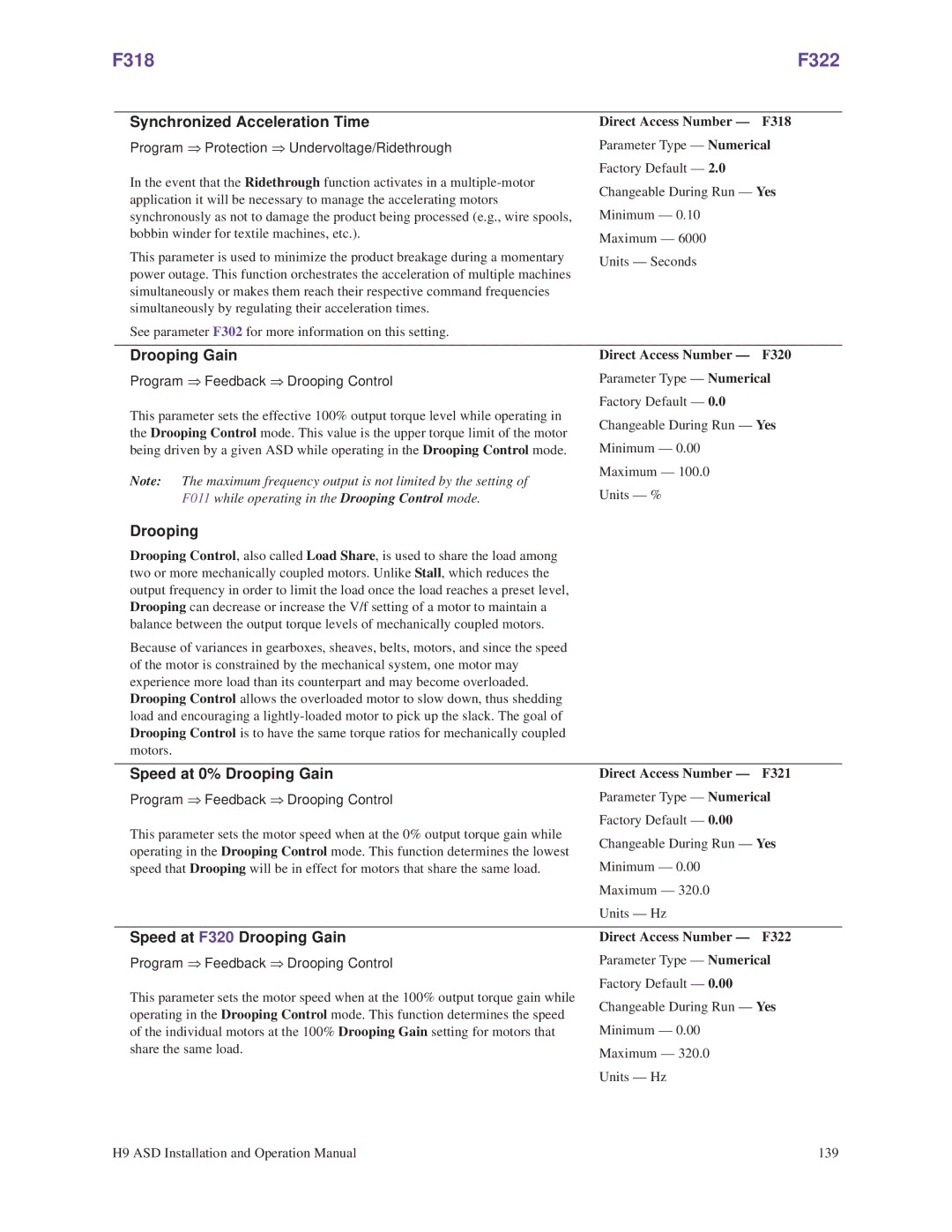F318 |
| F322 | |
|
|
|
|
| Synchronized Acceleration Time | Direct Access Number — | F318 |
| Program ⇒ Protection ⇒ Undervoltage/Ridethrough | Parameter Type — Numerical | |
| In the event that the Ridethrough function activates in a | Factory Default — 2.0 |
|
| Changeable During Run — Yes | ||
| application it will be necessary to manage the accelerating motors | ||
|
|
| |
| synchronously as not to damage the product being processed (e.g., wire spools, | Minimum — 0.10 |
|
| bobbin winder for textile machines, etc.). | Maximum — 6000 |
|
|
|
| |
| This parameter is used to minimize the product breakage during a momentary | Units — Seconds |
|
| power outage. This function orchestrates the acceleration of multiple machines |
| |
|
|
| |
| simultaneously or makes them reach their respective command frequencies |
|
|
| simultaneously by regulating their acceleration times. |
|
|
| See parameter F302 for more information on this setting. |
|
|
|
|
|
|
| Drooping Gain | Direct Access Number — | F320 |
| Program ⇒ Feedback ⇒ Drooping Control | Parameter Type — Numerical | |
| This parameter sets the effective 100% output torque level while operating in | Factory Default — 0.0 |
|
| Changeable During Run — Yes | ||
| the Drooping Control mode. This value is the upper torque limit of the motor | ||
|
|
| |
| being driven by a given ASD while operating in the Drooping Control mode. | Minimum — 0.00 |
|
| Note: The maximum frequency output is not limited by the setting of | Maximum — 100.0 |
|
| Units — % |
| |
| F011 while operating in the Drooping Control mode. |
| |
| Drooping |
|
|
| Drooping Control, also called Load Share, is used to share the load among |
|
|
| two or more mechanically coupled motors. Unlike Stall, which reduces the |
|
|
| output frequency in order to limit the load once the load reaches a preset level, |
|
|
| Drooping can decrease or increase the V/f setting of a motor to maintain a |
|
|
| balance between the output torque levels of mechanically coupled motors. |
|
|
| Because of variances in gearboxes, sheaves, belts, motors, and since the speed |
|
|
| of the motor is constrained by the mechanical system, one motor may |
|
|
| experience more load than its counterpart and may become overloaded. |
|
|
| Drooping Control allows the overloaded motor to slow down, thus shedding |
|
|
| load and encouraging a |
|
|
| Drooping Control is to have the same torque ratios for mechanically coupled |
|
|
| motors. |
|
|
|
|
|
|
| Speed at 0% Drooping Gain | Direct Access Number — | F321 |
| Program ⇒ Feedback ⇒ Drooping Control | Parameter Type — Numerical | |
| This parameter sets the motor speed when at the 0% output torque gain while | Factory Default — 0.00 |
|
| Changeable During Run — Yes | ||
| operating in the Drooping Control mode. This function determines the lowest | ||
|
|
| |
| speed that Drooping will be in effect for motors that share the same load. | Minimum — 0.00 |
|
Maximum — 320.0
Units — Hz
Speed at F320 Drooping Gain
Program ⇒ Feedback ⇒ Drooping Control
This parameter sets the motor speed when at the 100% output torque gain while operating in the Drooping Control mode. This function determines the speed of the individual motors at the 100% Drooping Gain setting for motors that share the same load.
Direct Access Number — F322
Parameter Type — Numerical
Factory Default — 0.00
Changeable During Run — Yes
Minimum — 0.00
Maximum — 320.0
Units — Hz
H9 ASD Installation and Operation Manual | 139 |
